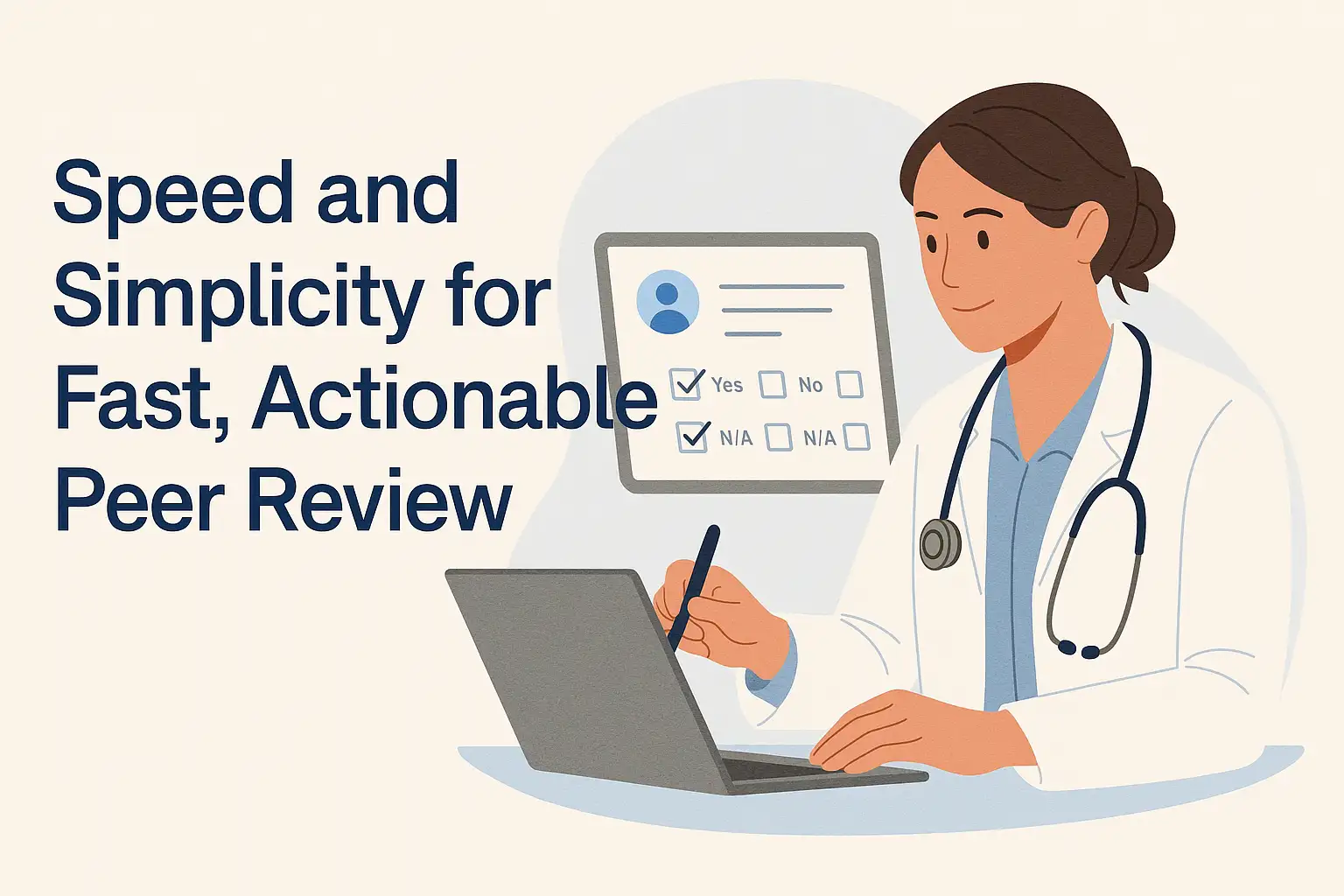
Table of Contents

How to Build a High-Quality Peer Review Process
Speed, simplicity, and smart design make peer review efficient and actionable—without burdening reviewers or sacrificing quality.
Building a high-quality peer review process isn’t just about meeting compliance—it’s about strengthening patient care, reducing risk, and fostering a culture of clinical excellence. For FQHCs, Critical Access Hospitals (CAHs), and Tribal health centers, a well-designed peer review system can uncover meaningful insights without overburdening providers or administrators.
Here’s how to get it right.
1. Start with a Purpose-Built, Digital Workflow
A high-quality peer review process should be digital-first. Manual paperwork wastes time and invites errors, delays, and compliance risk. When reviews are conducted in a digital system:
- Reviewers can access records easily and securely.
- Admins can track progress, completion rates, and documentation.
- Results are stored centrally for audits, reporting, and quality improvement.
Pro Tip: Use platforms that integrate with your existing workflows and minimize clicks. The more seamless the process, the more likely providers are to complete reviews accurately and on time.
2. Ensure the Turnaround Time Is Two Weeks or Less
Speed matters—especially for compliance and operational flow. HRSA, TJC, and other bodies expect reviews to be timely, and delays can result in findings during site visits. Establish a standard: reviews must be completed within 14 days.
This allows issues to be addressed while they’re still fresh, minimizes the risk of chart pile-up, and shows surveyors you have an efficient system in place.
3. Prioritize Unbiased, Expert Reviewers
Internal reviews often suffer from politics, bias, or inconsistency. Your process should ensure that:
- Reviewers have the appropriate license level and specialty for the encounters they’re reviewing.
- Objectivity is maintained, whether through external reviewers or well-defined reviewer selection protocols.
Bringing in external reviewers, even part-time, ensures a level of impartiality and rigor that internal systems often lack. It also helps eliminate the awkwardness of reviewing colleagues who are friends, rivals, or supervisors.
4. Design the Review to Focus on Analysis, Not Admin
Peer review should be a clinical exercise, not an administrative burden. Structure your process so that:
- Reviewers spend no more than 45–60 minutes reviewing 5 charts.
- The questions are clear, specialty-specific where needed, and organized in a tabular format for fast completion.
- Every “No” answer is accompanied by a meaningful comment, enabling improvement.
Invest in good design. If you’re going to ask clinicians to give their time, make it as streamlined and insightful as possible.
5. Random Sampling Over Reactive Review
One of the most powerful things you can do is to make random sampling the foundation of your peer review process. Many organizations only review charts after a bad outcome—but by then, it’s too late.
Instead, select charts randomly on a regular cadence (e.g., monthly or quarterly). This reveals:
- Suboptimal patterns of care before they lead to adverse events.
- Training opportunities across departments.
- Systemic issues that impact care quality.
This approach turns peer review from a punishment tool into a true quality improvement engine.
6. Provide Clear, Actionable Reports
Your review output should go beyond a checklist. High-quality peer review includes:
- A simple chart of questions and answers (Yes / No / N/A).
- Reviewer comments on each deficiency.
- An overall assessment with recommendations for follow-up or remediation.
- Optional summary reports for entire departments or provider groups.
And don’t forget the positive feedback—acknowledging excellent care is just as important as flagging concerns.
Build It Once, Use It Often
A strong peer review system is a strategic asset, not just a compliance requirement. By making the process digital, fast, unbiased, and useful, FQHCs and CAHs can drive clinical improvement, reduce liability, and satisfy regulators without creating provider burnout.
If you're not sure where to start, Medplace can help you design a peer review process that works—and implement it in weeks, not months.

Elevating Patient Safety: Responding to TJC Sentinel Event Data with Proactive External Peer Review
Learn how external peer review helps healthcare leaders proactively respond to TJC sentinel event data, ensuring objective, expert reviews, reducing risk, and boosting patient safety and compliance with Medplace.
.png)
.png)

Strengthening Patient Safety and Emergency Readiness: A CAH's Guide to 2025 CMS CoP Updates and Peer Review Best Practices
CAHs must strengthen patient safety & emergency readiness for 2025 CMS CoP updates. External peer review from Medplace offers objective, efficient, specialty-matched evaluations to reduce risk, improve compliance, and enhance provider satisfaction.
.png)
.png)

Beyond Billing Codes: Mastering 2025 CMS Changes with Enhanced Quality Oversight for FQHCs and RHCs
Master 2025 CMS changes for FQHCs/RHCs by elevating quality oversight. External peer review from Medplace reduces bias, boosts compliance, and strengthens grant competitiveness.
.png)
.png)



.png)
.png)
.png)


.png)




.png)